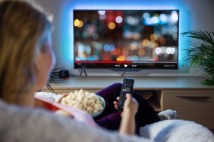We recently spotlighted kids’ TV shows and movies that are centering queer stories and characters, but, with the release of Pixar’s Luca, our panel of writers and editors couldn’t help but feel frustrated all over again. The reason? Luca feels like yet another example of queerbaiting — something that Disney is all too familiar with.
Birthed from LGBTQ+ fans and activists voicing their critiques on the internet, the term “queerbaiting” has been ascribed many definitions, but all of them link back to a central notion: Creators draw viewers in by suggesting queerness. They hook us and get us to pay for their content, but they don’t give us actual nuanced, on-screen representation.
Not only is queerbaiting a missed opportunity to portray the community as a whole in a realistic and authentic manner, but film and TV are also powerful tools with the potential to reach and educate audiences around the world.
From Queer Coding to Queerbaiting: A Brief History of LGBTQ+ Representation in Hollywood
In an article titled “The 25 Most Egregious Acts of Queerbaiting,” writers and editors at Autostraddle define it as “The act of playing into the chemistry, often even with established romantic tropes, between two women characters (at least one of whom has not declared her sexuality in such a way that your dad watching at home would know for absolute sure she’s gay) with no intention of ever putting those characters together, romantically or sexually.” Of course, that’s one of just a few definitions Autostraddle uses.
Another of the publication’s definitions asserts that queerbaiting can also be thought of in relation to how cishet (cisgender and heterosexual) romances are portrayed. Take, for example, Supergirl’s Kara Danvers (a.k.a. Supergirl) and Lena Luthor; their chemistry, and the emotional highs and lows that unfold between them, feel like all the ingredients to an epic superhero love story — and if they were a cis man and cis woman, there’d be no doubt as to how the pair’s “will they, won’t they” would play out.
However, queerbaiting cannot be untangled from film and TV’s past. We’re thinking specifically of the Hays Code — guidelines of self-censorship that restricted what could be shown in films. Developed by the forerunner to the now-Motion Picture Association of America (MPAA), the Hays Code restricted Hollywood films created between 1934 and 1968, stating, among other things, that “perverse” subjects, such as queerness, couldn’t be depicted on screen.
The result? Queer coding. These days, queer coding is often associated with negatives — understandably so, since it’s a double-edged sword. When employed by queer and trans folks, who were eager to see themselves on screen but needed to do so strategically due to the Hays Code, queer coding allowed for subtextual queerness — for characters to seem queer, to exist for those who knew (and needed) to look for them. For example, even as recently as the ’90s, the queer coded Xena (Lucy Lawless) and Gabrielle (Renee O’Connor) were claimed by LGBTQ+ fans.
However, queer coding, when used by bigoted creators, also gave way to myriad harmful stereotypes. Even now, both LGBTQ+ characters and queer and trans people are still dealing with the ramifications of those dangerous tropes. From the “predatory queer person” trope seen in Dracula’s Daughter (1936) to Disney’s decades’ worth of queer coded villains, films have forced a harmful (and false) narrative that links queerness and immorality.
As exemplified by the ’90s show Xena: Warrior Princess, queer fans have found ways to see themselves reflected on screen, to grasp at representation even when there isn’t any. We’ve become experts in grey areas and allegories. Not being used to explicit representation, we’ve formed our own queer readings to find a character, situation or relationship that’s identifiable. Film is a visual language that was born during a time of censorship, coding and stereotypes, so how do we undo the syntax of film history and carve out meaningful representation?
Disney’s Queerbaiting Problem Has Real Consequences
After watching Pixar’s Luca three times during its release weekend, Ask Media Group’s Senior Managing Editor Michael Kasian-Morin ended with tears of anger and frustration. “I’ve always felt disconnected from Disney. I’ve never seen myself in these stories. I think I watched it [Luca] so many times because I longed for an innocent representation of young-love among people of the same sex, and this was such a golden opportunity,” he said during a virtual roundtable chat with Ask’s editors and writers. “Are they really giving us a story like Luca and then completely denying it’s about our community? Will there ever be any actual storytelling about young queer romance? Don’t tease us like this — it’s almost more offensive.”
Luca, which centers the story of two sea monsters and teenagers in an Italian seaside town but only teases at the attraction between the two of them, is the last in a series of Disney movies and TV shows falling short when it comes to LGBTQ+ representation. We’ve already told you about The Falcon and the Winter Soldier giving the Sam-and-Bucky-shipping audience some breadcrumbs to make us believe something was going on between the two characters (interlocked legs during a couple’s therapy session, anyone?), only to never recognize their attraction.
“There’s a character [in Cruella] who is like super queer-coded but they won’t come out and say: ‘He’s gay,'” explains Editor Hannah Riley about the fashion designer Artie (John McCrea) in yet another 2021 Disney title. Hannah is also baffled at the idea of a movie for children in which one of the subplots involves the possibility of the main character killing puppies to make a coat but acknowledging a gay character doesn’t cut it.
Those three recent examples are far from all the cases of insufficient or inadequate queer representation in Disney content. The studio has been touting its own horn at inclusion for years with highly publicized moments you probably missed if you didn’t pay 110% of your attention. We’re talking about Disney’s first-ever gay character in the live-action version of Beauty and the Beast, the supposedly lesbian couple in Pixar’s Finding Dory, the fleeting moment in Avengers: Endgame in which director Joe Russo cameos as someone who lost his same-sex partner during the Snap or the easy-to-never-see kiss between two women at the end of Star Wars: The Rise of Skywalker.
Editor Kate Bove refers to these as easy-to-edit-out moments. And they do get edited out sometimes. Star Wars’ same-sex kiss was cut from the Singaporean and United Arab Emirates version of the film. The gay scene in Beauty and the Beast almost didn’t pass Malaysian censorship. In the end, the movie was released there, after Disney refused to cut the scene. Both veiled instances passed Chinese censorship, however. That’s relevant because China’s box-office share in the global market was 25.4% in 2020, and the country’s slice of the ticket-sales pie has been significantly bigger in the last decade. “It does feel like they’re playing to the dollar and not to anything else,” says Kate.
Hannah, who has a soft spot for South Park, brings up the show’s episode “Band in China,” in which Randy tries to expand his marijuana business in China, to better illustrate the issue. “He works with Mickey Mouse and Mickey’s point throughout this episode is that they have to keep things palatable for distribution in other countries, they have to maintain that ambiguity so that they can send this stuff worldwide.”
But that aim at palatability for a worldwide market ends up causing fatigue for the LGBTQ+ community and their many allies. “Where have queer people seen themselves in Disney films?” says Writer Eric Mueller, pointing out the queer coding in a lot of Disney’s villains — from Captain Hook in Peter Pan (1953) to Ursula in The Little Mermaid (1989), Jafar in Aladdin (1992) and the titular role in Maleficient (2014). “When are we going to see just an objectively nice either young queer person trying to come of age or young queer love? When are we going to stop seeing ourselves in these darker roles, as opposed to the protagonists?”
Kate mentions yet another 2021 Disney movie, Raya and the Last Dragon. Lead actress Kelly Marie Tran, who voiced Raya, has been very open about believing her character was gay. “I felt the relationship between her and the other lead woman [voiced by Gemma Chan] had that potential and there was just a lot of chemistry,” says Kate about the movie. “If that other character had been a man, it would have been an enemies-to-lovers kind of storyline. That’s another way that queerbaiting crops up for me, when it feels like if I were to compare this to a cishet depiction of characters, they would go a different way.”
Disney launched its first full line of LGBTQ+ merchandise ahead of Pride month this year, but more than a sign of real change, for Michael it feels like a corporate move to capitalize on the pink dollar. “I’d much prefer seeing our stories told through your production company,” he says.
Things could be starting to change, though. The same week Ask’s team gathered to have this chat, Disney+ released the third episode of the Marvel show Loki, in which its titular character (Tom Hiddleston) openly declares his bisexuality to the variant Sylvie (Sophia Di Martino). Does this mean a shift in representation is on the horizon?
Tired and a Little Angry: Hoping for a Less “Coded” Future
If you compare films today with those released in the early to mid-20th century, the number of queer characters (or, queer coded characters) on-screen has improved — but it doesn’t always feel that way because they often aren’t the main focus. The marketing might be different in that may hint at or tease a queer character. A film’s director or actors might acknowledge the queerness of a character they wrote or played. Ultimately, queer representation needs to be explicitly queer because people are tired of making their own queer canons.
For decades now, queer people have had to do their own readings, interpretations and decoding to see themselves represented in media. Fans are able to push back from the queer hype and inevitable letdowns by making their own fanart and penning their own fanfiction, which can be particularly empowering.
Think about all the energy it takes to construct a queer canon, whether mentally, written down and posted online or expressed in another way. Doing the work to “queer” a text takes a lot of energy. If queer people were more satisfied with how they saw themselves on-screen, that energy might be better allocated to other community needs.
What happens when that same energy becomes something like hope or anger? “Queer shipping” is the term usually applied to the desire to see two characters romantically linked in a way that places them somewhere on the queer spectrum. In situations like that of the anime My Hero Academia, fans have allegedly sent death threats to the show’s artist on social media, professing passionate support for male characters that they want to see in love. This is not a good look, but the demand for actual queer representation may continue to heighten as this goes on.
Aside from the satisfaction for queer viewers, making characters explicitly queer can help educate others on their experiences, along with the similarities and differences they face. Representation does more than help the group being represented: It can teach empathy.
Empathy and real action are needed now more than ever. In 2021, states in the U.S. have tried passing more than 100 bills that specifically attack transgender people, mostly trans youth. The time to take a stand — to demand more (and more positive) representations of queer people in various forms of media — is yesterday. It’s time for Disney to finally end its performative allyship and put queer characters in the spotlight.






